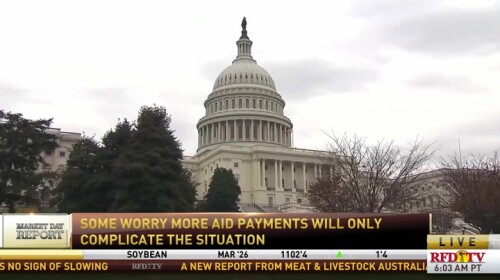Soybeans
Experts say flooding the zone with more money could have unintented consequences without opening new markets for planted crops and inputs under significant pressure.
Corn and wheat exports continue to outperform last year, while soybeans show steady but subdued movement compared to 2024.
While this month’s WASDE report will not include updated figures on U.S. crop size, officials say it will offer a clearer picture of crop conditions in the Southern Hemisphere.
USTR Jamieson Greer signals a narrower trade deal with China, adding more market uncertainty. The Farm Bureau also supports reviewing China’s missed trade commitments under the Phase One.
Southern producers head into 2026 with thin margins, tighter credit, and rising agronomic risks despite scattered yield improvements.
Credit stress is building for row-crop farms despite steady land values and slight price improvements.
American soybean and corn leaders, along with Canada’s AgriFood sector, testified before the U.S. Trade Representative’s Office in support of the trade pact between the U.S., Mexico, and Canada.
China’s renewed purchases signal improving sorghum demand at a time when export markets are otherwise uneven. Meanwhile, agriculture groups across the U.S, Canada, and Mexico want to protect close trade relations.
Pressure on grain storage capacity and stronger export positioning are pushing more grain onto railroads, highways, and river systems as logistics become a key bottleneck this fall.
Tryston Beyrer, Crop Nutrition Lead at The Mosaic Company, examines planning trends as producers weigh corn and soybean plantings for 2026.
Despite the need for swift action, many ag lawmakers and industry groups argue that farm aid alone will likely not be sufficient to help farmers without improved trade relations with China.
Corn exports remain strong, while soybeans and wheat shift week to week on river conditions and global demand.
Row crop losses in 2025 are outpacing last year. With no disaster aid yet approved, many operations face a tough financial bridge to 2026 even as Farm Bill improvements remain a year away.
Heavy rains are wreaking havoc on Argentina’s farmland, leaving nearly 4 million acres at risk and delaying corn and soybean plantings in one of the world’s top grain export regions.
Bangladesh recently pledged to purchase 700,000 tons of U.S. wheat and has also become a new buyer of American soybeans.
Lewis Williamson with HTS Commodities shares an update on post-WASDE grain movement, with corn leading export momentum, soybeans steady, and wheat and sorghum continuing to move selectively.
China still has a long way to go before it meets its commitment to buy 12 million metric tons of U.S. soybeans this year.
Strong U.S. yields and steady demand leave most major crops well supplied, keeping price pressure in place unless usage strengthens or weather shifts outlooks.
While agriculture doesn’t predict every recession, the sector’s long history of turning down before the broader economy
ARC-CO delivers the bulk of 2024 support, offering key margin relief as producers manage tight operating conditions.
As economic pressures continue to squeeze agriculture, ag lenders are signaling a more cautious outlook for farm profitability heading into next year, particularly among grain producers facing lower commodity prices and higher operating costs.
USDA released the November WASDE Report on Friday, the first supply-and-demand estimate to drop since September, just before the 43-day government shutdown.























